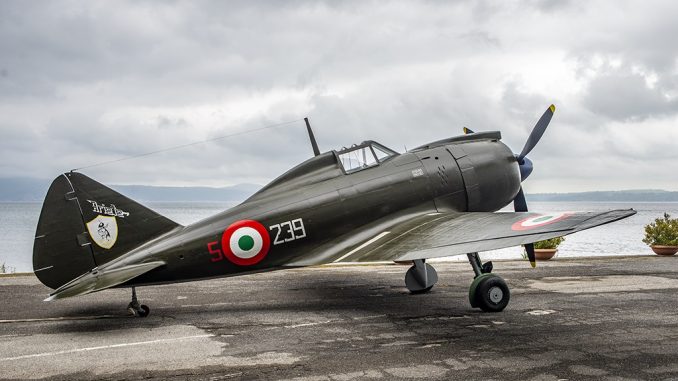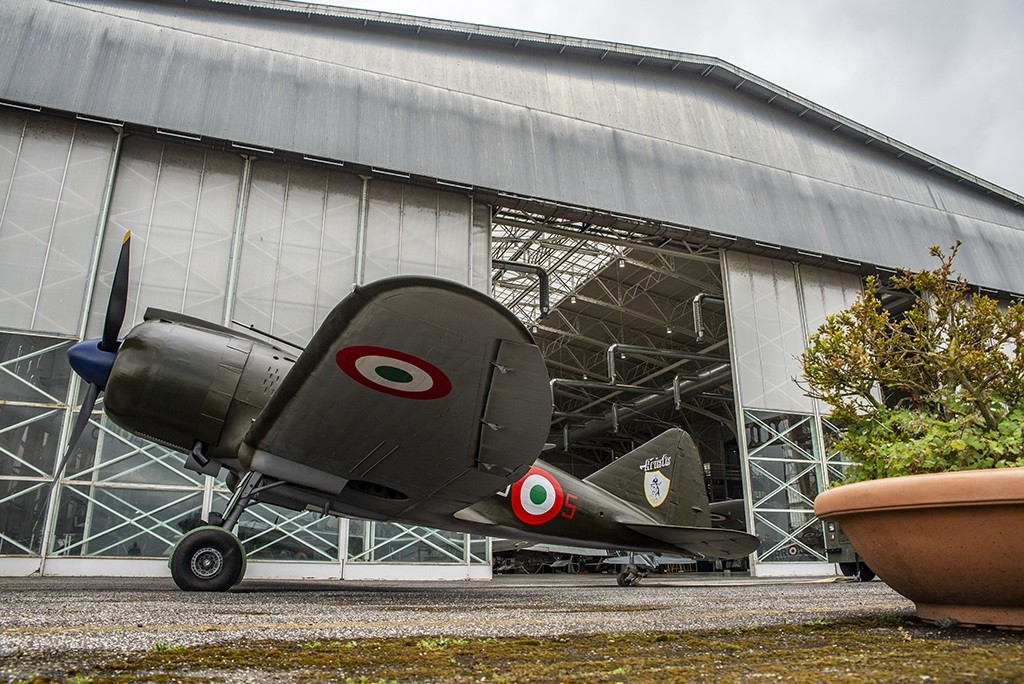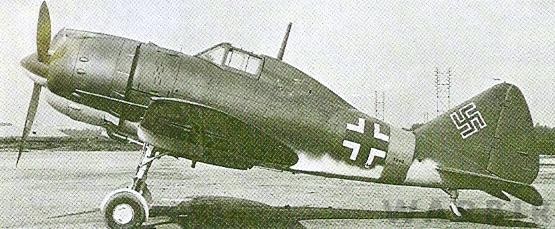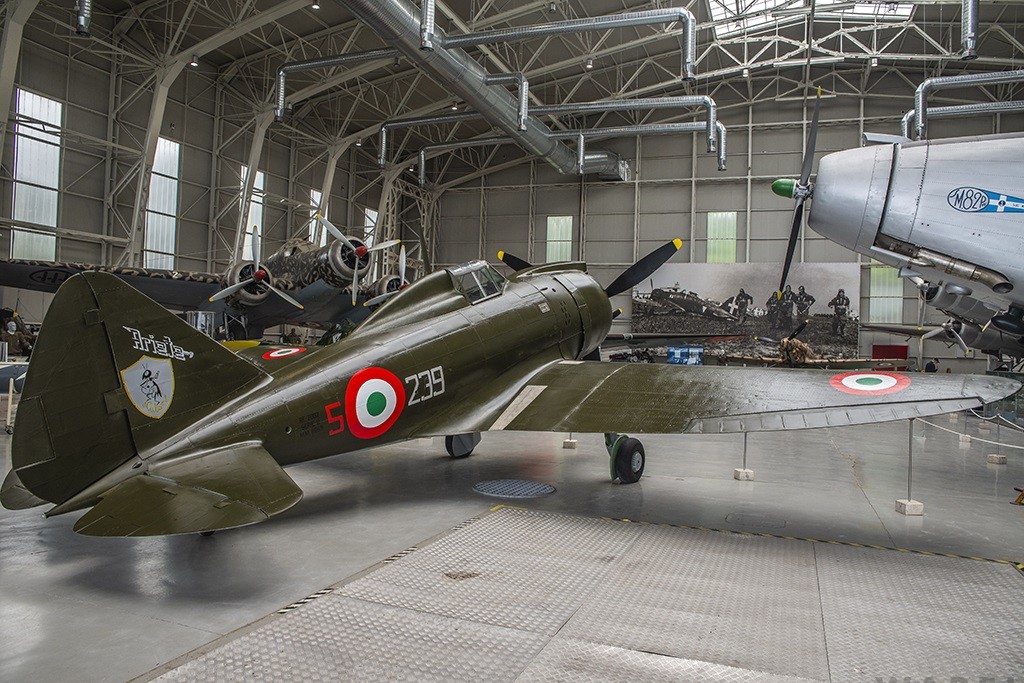
After a four year restoration, conducted by the specialists at the Museo Storico dell’Aeronautica Militare (Italian Air Force Museum) in Vigna di Valle, Italy, an ultra-rare Reggiane Re.2002 is now on public display within the museum’s Badoni hangar.
This WWII-era fighter bomber arrived at Vigna di Valle on October 12th, 2017, a date which also marked the museum’s 40th anniversary. While the aircraft appeared to be complete at the time, it still required considerable work to bring it up to museum standards. So, while the aircraft went on display for a brief period as part of the museum’s anniversary celebrations, it soon re-entered the maintenance workshop for further rework. During the aircraft’s most recent period of refurbishment, the restoration team addressed a number of issues, from relatively simple details like aileron alignment, to more complex problems, which included the complete scratch-build fabrication of the left trim flap, wing hard points, wing and fuselage gun ports, radio antenna, external light bays, pitot tube, viewfinder, engine exhausts, all the fairing latches and the ventilation slots on the engine accessory section paneling. The team completed this work in collaboration with restorer Marco Gueli.
This airframe, the sole complete example of the type, is based upon an incomplete fuselage and wing which are believed to have come from airframe number 126, This airframe likely flew first during July, 1943. Initially assigned the Regia Aeronautica (Italian Air Force) serial MM8669, researchers believe the aircraft soon ended up requisitioned by the Luftwaffe, but her German serial number, if known, is not presently public knowledge. Post-war, her history is murkier still, but she owes her survival to the University of Bologna, which housed her remains, presumably as technical training aids, until the late 1960s when their historical importance was finally rediscovered. These components then ended up on display at the Caproni Museum, then housed within the old Caproni factory at Vizzola Ticcino. MM8669 remained there until the 1980s when she finally entered restoration, although this occurred in fits and starts across several locations during the decades which followed. Ostensibly ready for display in 2017, she was essentially an empty shell with a fair degree of additional work remaining to bring her up to proper display standard. This work is now complete, so the Re.2002 can finally go on display. The partially restored fuselage from another Re.2002, also with Luftwaffe heritage, is on display at the Musee de la Resistance du Massif Central in Limoges, France.

A development of the Re.2000, two of Reggiane’s most experienced aeronautical engineers, Roberto Longhi and Antonio Alesso, designed the Re.2002 Ariete (Aries) in the summer of 1940. The Re.2002 employed an updated Re.2000 wing, the same wing which the Re.2001 also fielded. And, just like the Re.2001, it incorporated a radial engine (in this case, a Piaggio P.XIX RC.45) with a modified Re.2000 fuselage. The 1,175hp engine gave the new design a top speed of 329 mph with a 685 mile range, quite a feat for the day. While the Regia Aeronautica ordered 200 airframes, Reggiane produced a total of 255 examples, with 106 of these going to Luftwaffe units.
The aircraft was relatively lightly armed, with a pair of 12.7 mm machine guns in the engine cowling and two 7.7mm machine guns in the wings. The central fuselage bomb rack could accomodate a 500kg bomb, while the two wing pylons were rated up to 160kg. While the prototype first flew in October 1940 the type did not reach operational squadrons until March 1942. Interestingly, the Germans liked the aircraft, and had placed an order for several hundred examples which they planned to operate with BMW 801 powerplants. However, this engine-airframe combination never reached operational status, although the Luftwaffe did operate several dozen Piaggio-powered examples in France.

The unique and freshly-restored Re.2002 is now on public display at the Italian Air Force Museum, which houses some 80 historic airframes, in addition to engines and aeronautical memorabilia of various kinds representing the history of military flying in Italy and those who served within the Italian Air Force.

The museum is located on the shores of the magnificent Lake Bracciano between the towns of Bracciano and Anguillara Sabazia and first opened in 1977. Its mission is to collect, restore, conserve, exhibit and enhance the aeronautical material of historical and documentary interest pertaining to the Italian Air Force. Through multiple internal and external initiatives, the museum is also a driving force of history and aeronautical culture from a scientific, educational and cultural point of view.
The Museum is admission free and open to the public each day from 10:00am to 4:00pm, with the exception of a few Mondays each year, New Year’s Day, Easter and Christmas Day. Please note that for Saturday or holiday entrance, it is essential to book your visit by phone (at least 24 hours in advance) by calling 06-99887509. For more information, please visit the museum’s website.



Looks great